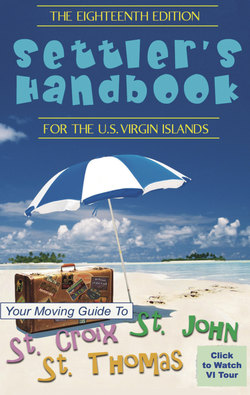Читать книгу VI Settler's Handbook - Mr. Cheyenne Harty - Страница 10
Explorers and Colonizers
ОглавлениеChristopher Columbus and his crew were the first Europeans to visit the area known now as the Virgin Islands. While sailing north in 1493 along the Lesser Antilles chain, toward the community he’d established in Hispaniola (now Haiti and the Dominican Republic), Columbus sighted an island. The fleet decided to anchor near a bay (Salt River) in hopes of finding fresh water. The bay, called “AyAy” (The River) by the Tainos and “Cibuguiera” (Stony Land) by the Caribs, was to be named “Santa Cruz” by Columbus. The French would later keep the Holy Cross designation and call it “Ste. Croix.”
Soldiers were dispatched in a longboat toward an Indian village for information. This landing party attacked some Caribs who approached in a canoe. A confrontation ensued, with at least one Spaniard and one Carib dying. Columbus, as a memorial to the dead Spaniard, named the site of the skirmish Cabo de las Flechas (Cape of the Arrows). Later, the Caribs would so harass the Spanish in Puerto Rico that they became a target for destruction and eventually retreated to other Carib communities on Dominica and Guadeloupe.
Columbus’ fleet turned north to explore the islands on the horizon. They sailed past Anegada and Virgin Gorda (the eastern-most of what are now the British Virgin Islands), past St. Thomas and St. John. The explorer was so impressed by the number of islands that he named them in honor of St. Ursula and her legendary 11,000 martyred virgin companions. He resisted the temptation to anchor, continued westward and finally landed along Puerto Rico’s west coast.
Though Spain claimed the Caribbean islands through Columbus’ explorations, she made little effort to colonize the Lesser Antilles because they had no mineral wealth. During the two centuries that followed, the Greater and Lesser Antilles were the scenes of battles between English, Dutch and French admirals, pirates and privateers, all attracted first by rumor of Spanish treasure and later by the region’s highly profitable products of cotton, sugar, rum, indigo and spices.
In the early 1640s, England and Holland were sparring over St. Croix. The English, farmers from the more settled island of St. Kitts, established a settlement around 1641 in the Salt River area of St. Croix. They would build a triangular earthwork structure to fortify their foothold. The structure, completed by the Dutch later, was called Fort Flamand (the Flemish fort) by the French. The Dutch West India Company also settled on the island around 1642. The English governor was killed and his settlers retaliated by killing the Dutch governor. The Dutch won, but allowed the English to remain. A few years later, the Dutch were forced out, leaving the English in control. In 1650, Spain would defeat and drive out the English. In 1650, the French surprised and defeated the Spanish garrison. The first French settlement was at Salt River; a later settlement was at the natural harbor on the north side of the island at present day Christiansted. They called it “Bassin.” From 1655 to 1665, the French Crown leased the islands to the French Chapter of the Knights of Malta. During that time, the island continued to produce cotton, indigo, tobacco, sugar and tropical foods. In the late 17th century, the French were forced to abandon the island. Then, all but deserted, the island was occasionally visited by pirates and smugglers. French war ships arrived periodically to maintain title for the crown. When the French abandoned St. Croix, English woodcutters from Tortola moved in and engaged in lumbering.
France sold St. Croix to the Danish West India and Guinea Company in 1733. Denmark took over as a Crown Colony in 1755. This struggle for control of the islands, St. Croix in particular, demonstrates how the Caribbean would ebb and flow, matching the battles that existed in Europe in the 17th and 18th centuries. Blackbeard and other infamous pirates used St. Thomas to sell their plunder. St. Thomas continued to be the main port, and goods from the islands were shipped in and out by both legitimate companies and by smugglers and pirates. The coves and inlets of the islands proved to be havens for the smuggling of goods. By this period, sugar plantations and small farms had been established on St. John. With Charlotte Amalie’s superb harbor, St. Thomas soon found its destiny as a trading center. In 1764 the island was proclaimed a free port. Many of the present-day Charlotte Amalie shops were once merchant warehouses with back doors facing the beaches and the harbor.
The Danes had become interested in sugar cultivation; the Danish West India and Guinea Company was chartered to expand the sugar plantations and control the African slave trade. Plantation agriculture began on St. Thomas, using Danish indentured servants as laborers. The first shipments of African slaves arrived in 1673. In 1717, the Danes added St. John to their territory.When the French sold the island of St. Croix, Danish settlers from the plantations on St. Thomas sailed to St. John to farm. In 1733, a violent slave rebellion on St. John dislodged the Europeans for six months.
